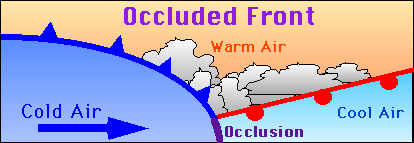| |
|
Occluded Fronts
Often, a cold front will travel faster than a warm front and will eventually catch up and overtake the warm front. The boundary created is called an occluded front or an occlusion. Here, the layer of warm air is lifted above both layers of cold air. Preceding the occluded front would be showers typical of a warm front. But as the front gets closer, more stormy-like conditions may prevail.

Meteorologists differentiate between two types of occluded fronts:
- cold-type occluded fronts ("cold occlusion"): the air behind the front is colder than the air in front of it
- warm-type occluded fronts ("warm occlusion"): the air behind the front is warmer than the air in front of it
The weather conditions associated with occluded fronts are shown below:
| Weather Element |
Before passing |
While passing |
After passing |
| Winds |
East, southest, or south |
Variable |
West or northwest |
| Temperature |
Cold type: cold or cool
Warm type: cold
|
Cold type: dropping
Warm type: rising
|
Cold type: colder
Warm type: milder
|
| Pressure |
Usually falling |
Low point |
Usually rising |
| Clouds |
In this order: cirrus, cirrostratus, altostratus, nimbostratus |
Nimbostratus, sometimes towering cumulus and cumulonimbus |
Nimbostratus, altostratus, or scattered cumulostratus |
| Precipitation |
Light, moderate, or heavy precipitation |
Light, moderate, or heavy continuous precipitation or showers |
Light to moderate precipitation followed by general clearing |
| Visibility |
Poor in precipitation |
Poor in precipitation |
Improving |
| Dew point |
Steady |
Usually slight drop, especially if cold-occluded |
Slight drop, although may rise a bit if warm-occluded |
Confused? Have a question? If so, check out the Frequently Asked Questions (FAQ) page or send mail to the OS411 tutor (os411tutor@shodor.org) with your question!
Report technical/content problems here
|
|
